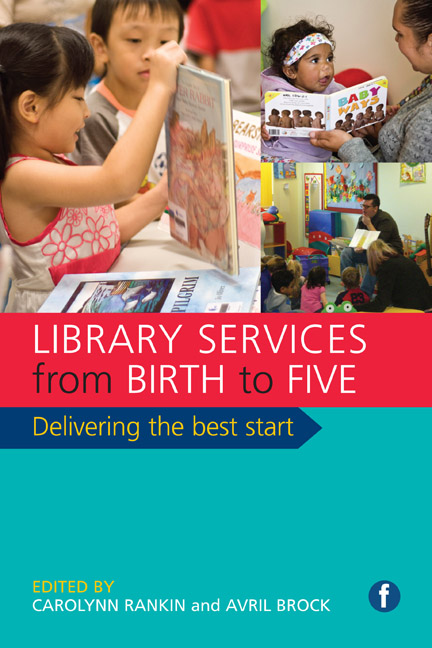Book contents
- Frontmatter
- Contents
- List of figures and tables
- Contributors
- Acknowledgements
- Introduction
- 1 Take them to the library: the pathway of opportunity
- 2 What you need to know about promoting early reading with young children from birth to five
- 3 Attribute value wrong, It should be `City of Literature ... it all starts with ABCD! The City of Melbourne and the Abecedarian Approach
- 4 Transforming practice through research: evaluating the Better Beginnings family literacy programme
- 5 People and partnerships, skills and knowledge
- 6 Resources for early years libraries: books, toys and other delights
- 7 Using digital media in early years library services
- 8 Using play to enhance early years literacy in babies and toddlers: ‘Read, Play and Grow’ at Brooklyn Public Library
- 9 Inclusive early literacy
- 10 Music and rhyme time sessions for the under-fives
- 11 Reaching your audience: the librarian's role
- 12 Successful library activities for the early years and ways to promote books effectively
- 13 Designing family-friendly libraries for the early years
- 14 Planning: organizing projects and money matters in the early years library
- Index
11 - Reaching your audience: the librarian's role
Published online by Cambridge University Press: 08 June 2018
- Frontmatter
- Contents
- List of figures and tables
- Contributors
- Acknowledgements
- Introduction
- 1 Take them to the library: the pathway of opportunity
- 2 What you need to know about promoting early reading with young children from birth to five
- 3 Attribute value wrong, It should be `City of Literature ... it all starts with ABCD! The City of Melbourne and the Abecedarian Approach
- 4 Transforming practice through research: evaluating the Better Beginnings family literacy programme
- 5 People and partnerships, skills and knowledge
- 6 Resources for early years libraries: books, toys and other delights
- 7 Using digital media in early years library services
- 8 Using play to enhance early years literacy in babies and toddlers: ‘Read, Play and Grow’ at Brooklyn Public Library
- 9 Inclusive early literacy
- 10 Music and rhyme time sessions for the under-fives
- 11 Reaching your audience: the librarian's role
- 12 Successful library activities for the early years and ways to promote books effectively
- 13 Designing family-friendly libraries for the early years
- 14 Planning: organizing projects and money matters in the early years library
- Index
Summary
Introduction
This chapter is presented in two parts and we look first at how the librarian can provide opportunities for young children and their families to enjoy literacy and language development activities together. In the UK the library service can be regarded as a key partner acting as a bridge to the community by providing a welcoming atmosphere. We further discuss introducing a love of books to babies and young children and the role of stories and story-telling in helping to develop the imagination. Many early years librarians tell stories at sessions, providing entertainment and enlightenment for their local community. Acknowledging the skills required to effectively connect and engage with a family audience, we offer practical guidance for the librarian as performer. Continuing the theme of partnerships, we discuss three examples of outreach work by looking at Traveller families, teenage fathers and culturally diverse communities. Partnerships are a key aspect of campaigns and promotional schemes and we look at some UKbased initiatives. Part 2 of the chapter provides a superb range of case studies that presents early years library provision delivered by partnerships in Australia, Croatia, Denmark, Italy, Northern Ireland, Russia and Sweden.
PART 1 REACHING YOUR AUDIENCE
Providing a welcoming atmosphere
Librarians want to reach the family audience so as to encourage literacy skills and help build sustainable communities. The well-planned early years library will provide a range of wonderful books, toys, treasure baskets and other creative resources for young users and their families. The environment in which these resources are offered also merits consideration, as audiences can be encouraged by sending positive messages. The librarian has an important role in helping children, and the adults with them, to feel comfortable and welcome in the library or early years setting. In planning a welcoming environment, children's craft and art work displayed on the walls can encourage links with the local community. In Chapters 5 and 13 we discuss how the physical aspects of the library can be planned to create a positive environment. In addition to the physical environment, the social atmosphere and ethos created by the library staff is an important factor in making families feel welcome.
- Type
- Chapter
- Information
- Library Services from Birth to FiveDelivering the best start, pp. 213 - 262Publisher: FacetPrint publication year: 2019

